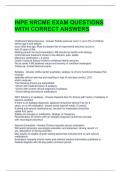Exam (elaborations)
INPE NRCME EXAM QUESTIONS WITH CORRECT ANSWERS
- Course
- Institution
INPE NRCME EXAM QUESTIONS WITH CORRECT ANSWERS Childhood Febrile Seizures - Answer-Febrile seizures occur in up to 5% of children before age 5 and seldom occur after that age. Most increased risk of unprovoked seizures occurs in first 10 years of life. Waiting period: No recommendation. ME shou...
[Show more]



